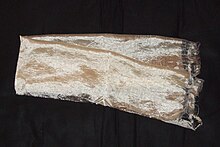| Khata | |||||||||||||||
|---|---|---|---|---|---|---|---|---|---|---|---|---|---|---|---|
 A Tibetan khata | |||||||||||||||
| Chinese name | |||||||||||||||
| Chinese | 哈達 | ||||||||||||||
| |||||||||||||||
| Tibetan name | |||||||||||||||
| Tibetan | ཁ་བཏགས་ | ||||||||||||||
| |||||||||||||||
| Mongolian name | |||||||||||||||
| Mongolian Cyrillic | хадаг | ||||||||||||||
| Mongolian script | ᠬᠠᠳᠠᠭ | ||||||||||||||
| Nepali name | |||||||||||||||
| Nepali | खतक khatak | ||||||||||||||
| Dzongkha name | |||||||||||||||
| Dzongkha | བཀབ་ནས | ||||||||||||||
| Buryat name | |||||||||||||||
| Buryat | хадаг khadag | ||||||||||||||
| Tuvan name | |||||||||||||||
| Tuvan | кадак kadak | ||||||||||||||
| Kyrgyz name | |||||||||||||||
| Kyrgyz | حاداق хадак hadak | ||||||||||||||

A khata /ˈkætə/ or khatag[1][a] is a traditional ceremonial scarf in Tibetan Buddhism and in Tengriism.[5][better source needed] It is widely used by the Tibetan, Nepalese, Bhutanese, Ladakhi, Mongolian, Buryat, and Tuvan peoples on various occasions. It originated in Tibetan culture and is common in cultures and countries where Tibetan Buddhism is practiced or has strong influence.[citation needed] The practice of using khatas has influenced people of other communities too who are in close relation to these communities. It is predominantly used in Tibet, followed by other parts of the world. It is a symbol of honour and respect. It is used in Tibetan religious ceremony and in traditional dances, and is offered in monasteries and in temples.
In Nepal, a khata is used as a gift for various occasions like wedding, graduation, electoral victory, winning an award and several other major lifestones. Generally, the guests or invitees at the reception would put khata on the host of such parties. It is used by both Hindus and Buddhists of Nepal in that manner.
- ^ Das, Sarat Chandra (1902). Rockhill., William Woodville (ed.). Journey to Lhasa and Central Tibet. London: Royal Geographical Society. p. 32. OCLC 557688339.
... handing him a scarf (khatag), I expressed the hope that we might meet next year.
- ^ 现代汉语词典(第七版) [A Dictionary of Current Chinese (Seventh Edition).]. 北京. Beijing: 商务印书馆. The Commercial Press. 1 September 2016. p. 505. ISBN 978-7-100-12450-8.
【哈达】 hǎdá
- ^ 现代汉语规范词典(第3版) [A Standard Dictionary of Current Chinese (Third Edition).]. 北京. Beijing: 外语教学与研究出版社. Foreign Language Teaching and Research Press. May 2014. p. 507. ISBN 978-7-513-54562-4.
【哈达】 hǎdá
- ^ "教育部《重編國語辭典修訂本》2021".
- ^ "The Eternal Blue Sky" (PDF). Hoop. 2014. Retrieved 2016-06-19.
Cite error: There are <ref group=lower-alpha> tags or {{efn}} templates on this page, but the references will not show without a {{reflist|group=lower-alpha}} template or {{notelist}} template (see the help page).